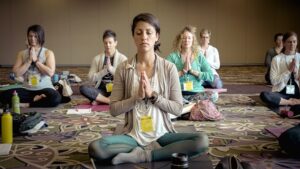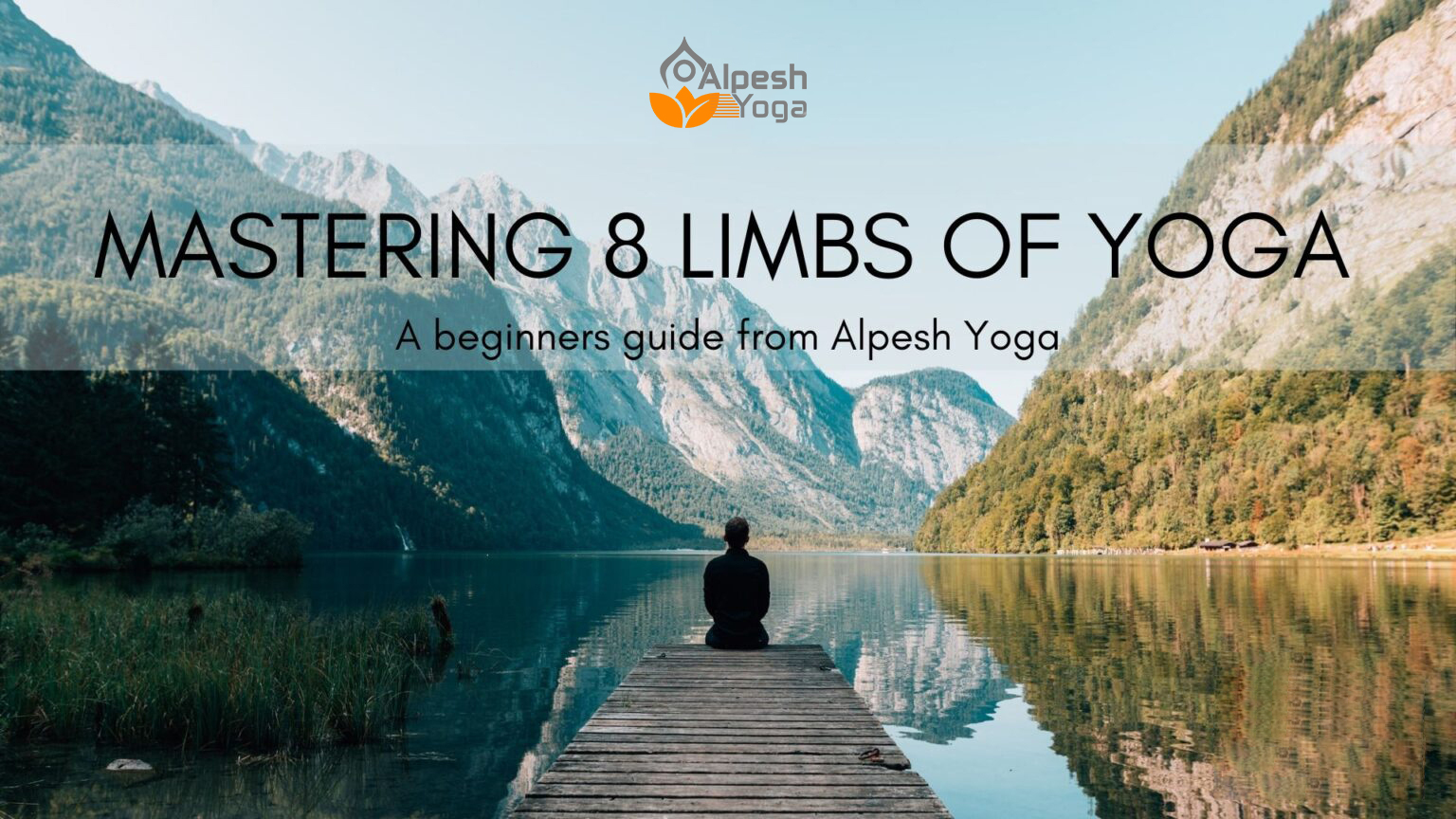8 limbs of yoga – also referred to as Patanjali’s yoga sutra, eightfold path, and raja yoga – helps people to live a meaningful life in the right flow by staying healthy and connected to the inner self. It was curated to help practitioners stay focused and live a more purposeful life.
While the yoga asanas focus mainly on the body, 8 limbs of yoga focus on transforming the suffering and inner struggles by disciplining the senses. Most people who are new to the world of yoga are not familiar with 8 limbs of yoga. That’s why Alpesh Yoga decided to elucidate 8 limbs of yoga and talk about all the important aspects.
Embrace the 8 limbs of yoga into your everyday life to connect with your inner self and deepen the understanding of yogic life. Below is detailed information about each of the 8 limbs of yoga
#Yama: Moral vows
The first limb of yoga, Yama refers to discipline and moral values that are mainly concerned with our surroundings and our interaction with them. The first of the 8 limbs of yoga prepares us to be kind, truthful, and use our soul in a worthwhile way by benefitting everything and everyone around us. Here are five Yamas:
Ahimsa (non-violence): It can be demonstrated by being kind to yourself, others, nature, and all other living things on the planet. It also includes eliminating negative thoughts from the mind and encouraging others to live life peacefully.
Satya (truth): It means to live an authentic life, being honest, and building better relationships, with people around you. Truth and calm come into our life if we continue to practice Satya every day.
Asteya (non-stealing): Asteya is the third Yama that educates us to live a life without stealing. In addition to physically taking away what belongs to someone else, it also covers mental theft. Wrongfully honoring your needs or stealing someone’s concept falls under Asteya.
Aparigrahat: This Yama educates us to live a simple life and obsess over nothing. In simple words, there is no need to be greedy.
Brahmacharya: This Yama tells us to have self-control without overindulging into the senses.
Implementing Yama into life
- Be nice and friendly while speaking to someone.
- Always own things that you really need.
- Don’t ever have thoughts of revenge for anything.
- Try to appreciate everyone rather than getting jealous.
By following these simple steps, you will be able to incorporate the first limb of yoga into your life.

#Niyama: Self-discipline
The second limb of yoga is all about self-discipline and spiritual observance. It guides us to live a healthy life by following a few sets of rules like visiting a temple daily, showing gratitude before a meal, and practicing personal meditation daily. Below are the guidelines for Niyama:
Saucha (cleanliness): The first Niyama, Saucha means cleanliness. It tells us to keep our body as well as mind clean.
Santosha: It means contentment, happiness, and mental calmness. Santosh guides us to live a stable life and be thankful for what we have.
Tapas: Tapas means to bring change to your life. It can be overcoming a bad habit, acquiring a new one, improving health, or taking a new direction in life.
Svadhyaya: This means self-study. It prepares us to go deeper into practice through self-examination. It’s an effort to know yourself through deep concentration.
Ishvara Pranidhana: It is referred to as devotion or surrender to the higher power. Being the last Niyama, it’s very difficult for an individual to embrace it.
Implementing Niyama into life:
- Choose carefully things that are willing to come into your life, be it food, emotion, or person.
- Meditate daily to avoid distractions in your lives.
- Integrate Ishvara Parnidhana in your daily life to beat the anxiety and stress building in your mind.
Yama and Niyama are an ethical practice that helps one to develop a yogic lifestyle.
#Asana: Physical practice
The third and the most popular limb of yoga is Asana which means physical practice. Asanas are the movements and postures we perform during yoga practice. Through the practice of asana, we develop the habit of discipline and concentration, both of which are necessary for meditation.
Benefits of integrating asanas into your daily life:
- It helps to fight depression and anxiety building up in our bodies.
- It creates mental, physical, and emotional balance in the body.
- It facilitates a healthier eating lifestyle.

#Pranayama: Breath control
Pranayama is the fourth limb of the eight-fold path of yoga. It consists of techniques designed to gain mastery over the breathing process while creating a connection between your mind, soul, and breath. Taking deep focused, rhythmic breaths makes the core of Pranayama, the fourth limb of yoga.
Benefits of performing Pranayama:
- Stimulates various body systems for improved health.
- Strengthens our respiratory system to cure breathing problems.
- Helps to improve sleep quality and reduce insomnia.
These four stages of Raja yoga concentrated on refining our personalities and gaining mastery over the body.
#Pratyahara: Withdrawal
The fifth limb of yoga, Pratyahara means disconnection of an individual from the outside world. The practice of Pratyahara provides us an opportunity to withdraw from the outer world and take a look at ourselves. Shifting your focus away from the habits that are detrimental to our health is the practice of Pratyahara, the fifth limb of yoga.
Benefits of integrating Pratyahara into your daily life:
- Reduces negative feelings like stress.
- Promotes inner joy and happiness.
- Good for the body and mind.
#Dharana- Concentration
Once you have mastered the fifth limb of yoga by blocking all the external stimuli, it’s time to implement Dharana, the sixth limb of yoga. In the practice of concentration, we learn meditation by slowing down the thinking process by concentrating on specific energy.
Dharana is not easy and requires repeat practice to master the power of concentration. To get a grip on this limb of yoga, you need to follow the following steps:
- Sit comfortably and close your eyes. Block all the surrounding distractions to focus on the third eye (the space between the two eyebrows).
- Try to focus and concentrate.
- When you feel your mind, body, and soul connect, bring your focus back to the third eye and breath slowly.
#Dhyana: Meditation
The seventh limb of yoga, Dhyana is a meditative state that comes after a long practice of Dharana. Dhyana is simplified as a state of quietness in the mind, shutting off the distraction from the outside world. In the meditative state of Dhyana, the mind becomes still and clear.
This is a difficult limb to master and it takes many years of practicing to access this meditative state. But that doesn’t mean you can’t access this state. Using the strength, discipline, and concentration from the Yama, Niyama, Asana, Pranayama, and Dharana, you can achieve this state over a period of time.

#Samadhi: Pure contemplation
The last limb of yoga, Samadhi refers to as an ultimate state of bliss, deep, enlightened, and everlasting connection to a divine source that was always present. After spending a long time in a meditative state and being in a permanent state of dhyana, you will experience Samadhi. This limb of yoga connects you with the universal consciousness.
All the eight limbs of yoga can be implemented into your daily life. All you need is the will to master them!
Above were the eight limbs of yoga. Practicing all the eight limbs will help you to connect with a divine force and lead a life full of bliss and enlightenment. After understanding the 8 limbs of the yoga tree, it will become easy for you to practice complex yoga poses and meditative states as well.
Got queries regarding yoga classes and practice? Email them at alpeshyoga@gmail.com to hear from experienced yoga practitioners.

